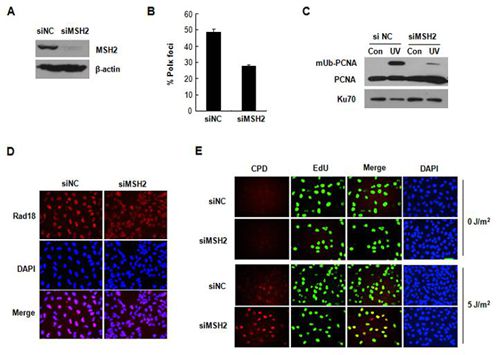Scientists Reveal a New Mechanism Regulates Translesion DNA Synthesis
The genome integrity is constantly threatened by a variety of endogenous and environmental factors. Most of DNA lesions can be discerned and repaired through multiple DNA repair mechanisms. However, some DNA lesions can escape from the surveillance of DNA repair mechanisms and lead to replication forks stalled during S phase.
To prevent stalled replication forks collapse, cells evolve a translesion DNA synthesis (TLS) system to incorporate nucleotides opposite damaged lesions by using low fidelity DNA polymerases. TLS includes an error-free pathway and an error-prone one. The former inserts correct nucleotides across DNA damage while the latter often inserts error ones.
Error-prone TLS is responsible for the most of genome mutations induced by environmental carcinogens and other DNA damage reagents. Therefore it is believed that reducing error-prone TLS might help to control carcinogenesis. So far it remains unclear how cells regulate TLS polymerases recruitment to perform their functions.
Recently, a research team led by Prof. GUO Caixia from Beijing Institute of Genomics, Chinese Academy of Sciences (CAS), revealed that mismatch repair protein MSH2 regulates TLS following exposure of cells to UV radiation. By employing immunoprecipitation combined with mass spectrometry, they found that DNA polymerase kappa (Polκ) can partner with MSH2, an important mismatch repair protein associated with hereditary non-polyposis colorectal cancer.
They found that MSH2 regulates post-UV focus formation by specialized DNA polymerases in both PCNA monoubiquitination-dependent and -independent fashions. Moreover, they observed that MSH2 can facilitate TLS across cyclobutane pyrimidine dimers photoproducts in living cells, presenting a novel role of MSH2 in post-UV cellular responses.
Additionally, a previous study of this group demonstrated that MSH2 can also regulate monoubiquitination of PCNA after oxidation damage. Together, these results are shedding lights on mechanisms of genome instability caused by recently identified non-classical mismatch repair, providing clues to develop novel strategies to prevent carcinogenesis and sensitize tumor cells for chemotherapy.
The work was finished by Prof.GUO’s group in collaboration with Prof. TANG Tieshan’s group in Institute of Zoology, CAS. The findings have been published on Nucleic Acids Research(doi:10.1093/nar/gkt793).
This research is supported by CAS, Ministry of Science and the National Natural Science Foundation of China.

Insights into regulation of translesion synthesis following exposure of cells to UV radiation by MSH2 (Image by Prof. GUO Caixia’ group)
Contact:
Prof. GUO Caixia
Email: guocx@big.ac.cn